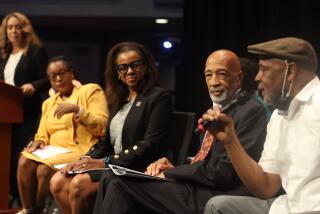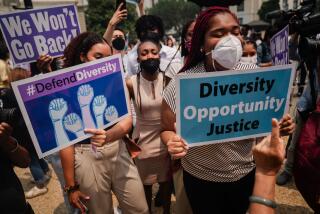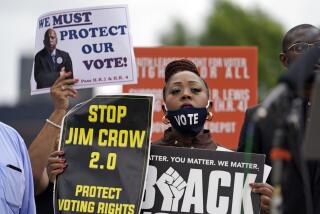SPECIAL REPORT: Race and Black America : Does America Need More Civil-Rights Laws?
- Share via
WASHINGTON — By focusing on quotas or no quotas, President Bush and Congress are grossly distorting one of the most critical questions facing this country. It is the question about race relations, and it is actually very simple:
Do we need stronger, additional civil-rights laws?
A 1991 study by the Urban Institute of employers in Washington, D.C., and Chicago reported that whites and blacks with the same qualifications were treated differently: More whites than blacks advanced in the hiring process and more blacks than whites were turned away.
Do we need additional, stronger civil-rights laws?
The national Center for Democratic Renewal, a clearinghouse aimed at countering hate crimes, says that hate-group membership is increasing and that bias crimes are common in every section of our country.
Do we need stronger, additional civil-rights laws?
In 1989, the U.S. Supreme Court overturned 18 years of established law. Among other things, the court in Wards Cove vs. Atonio allowed employers to use qualifications with no minimal relation to job performance, like a high school diploma, to turn minorities and women away. The President defends the court’s decision and wants Congress to affirm it because he says it will further educational reform. It is Willie Horton reborn--first as Mr. Quota, and now as a high school principal.
Do we need additional, stronger civil-rights laws?
A survey in May by the National Employment Lawyers Assn. reports that since the Supreme Court’s 1989 rulings, minorities and women have greater difficulty obtaining lawyers to take discrimination cases; when they are able to secure a lawyer, they have more difficulty proving discrimination in court.
Do we need additional, stronger civil-rights laws?
White men today are twice as likely as black men to hold sales, managerial or professional positions, 2 1/2 times as likely to hold any job at all.
Do we need additional, stronger civil-rights laws?
Four Los Angeles policemen beat a black man while more watched. Others routinely transmitted racist messages on their patrol-car computers.
Do we need stronger, additional civil-rights laws?
An Urban League report tells us that blacks lost, rather than gained ground in the 1980s. The numbers of blacks in college went down proportionally. The numbers in unemployment lines and prison went up.
Do we need additional, stronger civil-rights laws?
For nearly 200 years, white supremacy was the official policy of the United States, pronounced by its Presidents, codified by its legislatures, enforced by its courts and through private acts of terrorism, and sanctioned by all of its institutions. It created a two-tiered, racially based hierarchy in our nation, enshrined in custom and practice, accepted by the majority as natural and right.
For fewer than 30 years, we have tried to overcome that sorry history through the passage of corrective laws and social programs designed to rectify an inheritance of inequality. The civil-rights laws of 1964, 1965, 1968 and 1972, aided by generally favorable interpretations from the Supreme Court, began this process. But the sorry list above should demonstrate that the job done so far, while impressive, has been woefully inadequate.
America has long struggled to diversify and integrate its labor force. European immigrants were the flies in America’s buttermilk in the past; their attempts to enter industry were met with violence, amid charges that they represented an alien influence that would corrupt our national life. In the 19th Century, it was considered bad business practice to hire Italians or the Irish in the insurance industry, or to even sell insurance to Jews. But even as these immigrants were being absorbed, it remained official public policy to keep black America underdeveloped. By the end of the 19th Century, blacks were removed from skilled jobs, frozen out of labor unions, relegated to jobs at the bottom of the economy.
It is hardly surprising that American society remains racially divided today. In statistics measuring infant mortality, life expectancy and unemployment, rates of poverty, years of education completed and median family income, black Americans remain disproportionately mired at the bottom. In national-election returns and in surveys on attitudes toward race and the economy, black and white Americans stand on opposite sides of a deep chasm. Black voters think race relations are getting worse; by identical margins, white voters think they are getting better.
A national public opinion poll released this year shows that whites believe racial minorities are lazier, less intelligent, more prone to violence and less patriotic than whites.
The disparity between black and white life opportunities is not a factor of ghetto pathology; it is the natural consequence of racial discrimination, as are family breakdown, lack of middle-class values, lack of education and skills and the absence of role models. These are symptoms of lives without hope. Discrimination is the major cause. Its elimination is the primary cure.
Do we need additional, stronger civil-rights laws?
Of course we do. We need a strong law overturning the Supreme Court’s 1989 rulings, and we need vigorous enforcement of civil-rights laws already on the books. We need more than three decades to destroy a system of bigotry that took two centuries to erect.
But we ought not think that new laws alone will erase America’s racial fault line.
Supreme Court nominee Clarence Thomas admitted in 1982 that, as assistant secretary for civil rights in the Department of Education, he deliberately violated a court order requiring faster processing of discrimination charges. Thomas was not punished. Hundreds of victims of discrimination suffered. Even for this black man raised in poverty, the force of law was not enough to compel speedy attention to discrimination complaints.
The racial gulf is too wide and discrimination too ingrained to be healed by legislative pronouncements or court decisions alone. We need a national commitment to fairness and equality that surpasses empty rhetoric, that is acted out in daily life, from Pennsylvania Avenue to Main Street.
We need more than legal protection from discrimination and strong punishment for those who practice it; we also need to know that ending discrimination is a cause to which all Americans are devoted with equal fervor and determination.
When I was 10 years old, there were 15 workers supporting each retiree in the Social Security System. When I entered the job market, five workers paid into the Social Security system to provide benefits for each retiree. Their names were probably Bob, Carl, Steve, Frank and Bill. Today there are only three workers paying for every retired worker--their names might well be Kwanza, Jose and Maria.
We need to ensure that equal opportunity is a reality for them. We need--all of us--strong civil-rights laws.
Progress But Disparity
The percentage of African-American households with incomes over $25,000 has grown significantly in the past 20 years. Nonetheless, the disparity between the percentage of black and white families with middle and upper incomes remains wide, wider even than for Hispanic families.
Households with median annual income of $25,000 or more (in 1989 adjusted dollars) * Hispanic may be of any race Source: U.S. Bureau of the Census
Professional Gains
Just over 12% of the U.S. population is African-American, up from 10% in 1960. The percentage of college professors, physicians and lawyers who are black has grown since 1960 but blacks are still dramatically under-represented in these professions relative to their population.
Black--percent of total Source: U.S. Bureau of the Census
More to Read
Get the L.A. Times Politics newsletter
Deeply reported insights into legislation, politics and policy from Sacramento, Washington and beyond. In your inbox three times per week.
You may occasionally receive promotional content from the Los Angeles Times.










